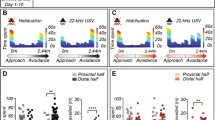Abstract
Male and female rats of the inbred Roman/Verh strains, which have been psychogenetically selected and bred for good (RHA-I/Verh) and extremely poor (RLA-I/Verh) two-way avoidance acquisition, were evaluated in an acoustic startle response test. One half of the rats of each strain and sex were previously subjected to 30 min of isolation by removal of their cage partners (“cohort removal”). During the testing session each animal received 40 acoustic stimuli at interstimulus intervals of 30 seconds. The hyperemotional RLA-I/Verh rats (especially the males) showed stronger acoustic startle responses than did their RHA-I/Verh counterparts. Startle amplitudes of the RLA-I/Verh males were further enhanced by the stress of 30 min isolation, whereas cohort removal did not significantly affect startle response amplitudes in RHA-I/Verh rats of either sex or in females of the RLA-I/Verh strain.
Similar content being viewed by others
REFERENCES
Adamec, R. E., Shallow, T., and Budgell, J. (1997). Blockade of CCK(B) but no CCK(A) receptors before and after the stress of predator exposure prevents lasting increases in anxiety-like behavior: Implications for anxiety associated with post-traumatic stress disorder. Behav. Neurosci. 111:435–449.
Davis, M., Falls, W. A., Campeau, S., and Munsoo, K. (1993). Fearpotentiated startle: A neural and pharmacological analysis. Behav. Brain Res. 58:175–198.
Driscoll, P., and Bättig, K. (1982). Behavioral, emotional and neurochemical profiles of rats selected for extreme differences in active, two-way avoidance performance. In Lieblich, I. (ed.), Genetics of the Brain, Elsevier Biomedical Press, Amsterdam, pp. 95–123.
Driscoll, P., Escorihuela, R. M., Fernández-Teruel, A., Giorgi, O., Schwegler, H., Steimer, Th., Wiersma, A., Corda, M. G., Flint, J., Koolhaas, J. M., Langhans, W., Schulz, P. E., Siegel, J., and Tobeña, A. (1998). Genetic selection and differential stress responses: the Roman lines/strains of rats. Ann. N.Y. Acad. Sci. 851:501–510.
Escorihuela, R. M., Tobeña, A., Driscoll, P., and Fernández-Teruel, A. (1995). Effects of training, early handling and perinatal flumazenil on shuttle box acquisition of Roman low-avoidance rats: Toward overcoming a genetic deficit. Neurosci. Biobehav. Rev. 19:353–367.
Escorihuela, R. M., Fernández-Teruel, A., Gil, L., Aguilar, R., Tobeña, A., and Driscoll, P. (1999). Inbred Roman high-and lowavoidance rats: Differences in anxiety, novelty seeking and shuttle box behaviors. Physiol. Behav. 67:19–26.
Fernández-Teruel, A., Escorihuela, R. M., NÚñez, J. F., Zapata, A., Boix, F., Salazar, W., and Tobeña, A. (1991). The early acquisition of two-way (shuttle-box) avoidance as an anxietymediated behavior: psychopharmacological validation. Brain Res. Bull. 26:173–176.
Frankland, P. W., Josselyn, S. A., Bradwejn, J., Vaccarino, F. J., and Yeomans, J. S. (1997). Activation of amydala cholecystokininB receptors potentiantes the acoustic startle response in the rat. J. Neurosci. 17:1838–1847.
Lang, P. J., Bradley, M. M., and Cuthbert, B. N. (1990). Emotion, attention and the startle reflex. Psychol. Rev. 97:377–395.
Lecci, A., Borsini, F., Volterra, G., and Meli, A. (1990). Pharmacological validation of a novel animal model of anticipatory anxiety in mice. Psychopharmacology 101:255–261.
Liang, K. C., Melia, K. R., Miserendino, J. D., Falls, W. A., Campeau, S., and Davis, M. (1996). Corticotropin-releasing factor: long-lasting facilitation of the acoustic startle reflex. J. Neurosci. 12:2303–2312.
Pelton, G. H., Lee, Y., and Davis, M. (1997). Repeated stress, like vasopressin, sensitizes the excitatory effects of corticotropin releasing factor on the acoustic startle reflex. Brain Res. 778:381–387.
Roozendaal, B., Wiersma, A., Driscoll, P., Koolhaas, J. M., and Bohus, B. (1992). Vasopressinergic modulation of stress responses in the central amygdala of the Roman high-avoidance and low-avoidance rat. Brain Res. 596:35–40.
Schwegler, H., Pilz, P. K. D., Koch, M., Fendt, M., Linke, R., and Driscoll, P. (1997). The acoustic startle response in inbred Roman high-and low-avoidance rats. Behav. Genet. 27:579–582.
Steimer, Th., La Fleur, S., and Schulz, P. E. (1997). Neuroendocrine correlates of emotional reactivity and coping in male rats of the Roman high (RHA/Verh)-and low (RLA/Verh)-avoidance lines. Behav. Genet. 27:503–512.
Trullás, R., Havoundjian, H., Zamir, N., Paul, S., and Skolnick, P. (1987). Environmentally-induced modification of the benzodiazepine/ GABA receptor coupled chloride ionophore. Psychopharmacology 91:384–390.
Walker, D. L., and Davis, M. (1997). Double dissociation between the involvement of the bed nucleus of the stria teminalis and the central nucleus of the amygdala in startle increases produced by conditioned versus unconditioned fear. J. Neurosci. 17:9375–9383.
Author information
Authors and Affiliations
Rights and permissions
About this article
Cite this article
Aguilar, R., Gil, L., Tobeña, A. et al. Differential Effects of Cohort Removal Stress on the Acoustic Startle Response of the Roman/Verh Rat Strains. Behav Genet 30, 71–75 (2000). https://doi.org/10.1023/A:1002042711672
Issue Date:
DOI: https://doi.org/10.1023/A:1002042711672




